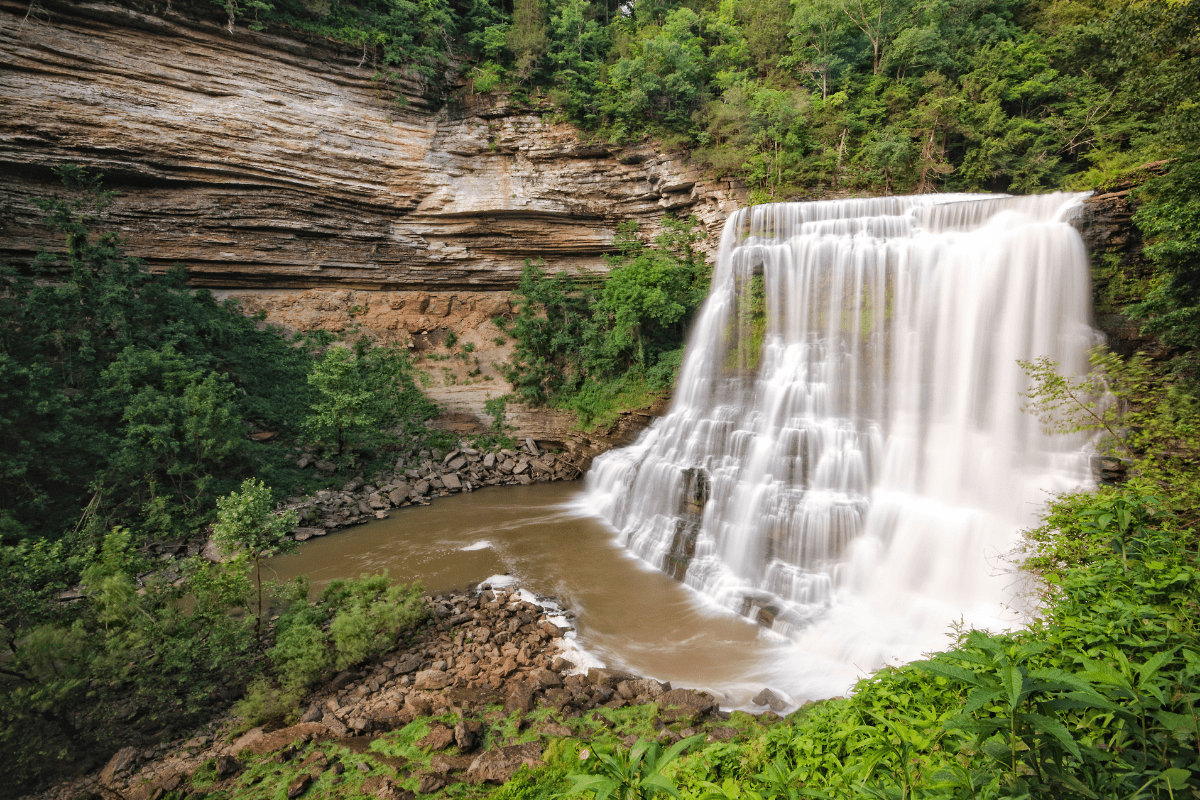Tennessee attracts 147 million annual visits to famous spots like Graceland and the Great Smoky Mountains, but honestly? The best stuff is hiding where tourists never think to look. From underground lakes to earthquake-formed wetlands, these 15 hidden gems each welcome fewer than 100 daily visitors… compared to the thousands cramming into the usual attractions.
Going underground in East Tennessee
Let's start with something that sounds made up but isn't: America's largest underground lake sits 140 feet beneath Sweetwater, Tennessee. The Lost Sea Adventure takes you deep into Craighead Caverns, where a 4.5-acre lake earned a Guinness World Record for being exactly what it claims. Glass-bottom boats glide over crystal-clear water stocked with rainbow trout, and thanks to the constant 58°F temperature, you'll either need a jacket or appreciate nature's air conditioning, depending on your cold tolerance.
The Cherokee used these caves long before tourists showed up. Confederate soldiers mined saltpeter here for gunpowder (because of course they did), and scientists found 20,000-year-old jaguar remains in the depths. That's right… jaguars. In Tennessee. Wild times.
Practical stuff you actually need to know
Adult tickets cost $26.95, which seems steep until you realize you're literally boating inside a mountain. Tours leave every 15-30 minutes from 9 AM to 5 PM daily, and the ¾-mile round trip descends seven stories. Wear real shoes, not those cute sandals you packed. Book online for weekends unless you enjoy disappointment.
Pro tip that tour guides won't tell you: Hit the Little Debbie Factory Store on your way out. Where else can you explore ancient geological wonders and stock up on Zebra Cakes in the same afternoon?
For those who really want to avoid crowds, Cherokee Caverns near Knoxville opens only 4-6 times annually for special events. This 300-million-year-old cave system hosts "Movies in the Cave" screenings and Christmas celebrations that sell out faster than Taylor Swift tickets. Well, maybe not that fast, but the 50-200 person capacity means you need to stalk their Facebook page like it's your job.
Free mountain views that beat paid attractions
Beauty Spot in Unicoi County proves that the best things in Tennessee really are free. This natural grass bald on the Appalachian Trail offers 360-degree mountain views after a 4.6-mile roundtrip hike. Even on "busy" days, you'll share the summit with maybe 30 other people who figured out that sunrise views here rival anything you'd pay to see.
GPS coordinates are 36.1089° N, 82.2794° W, but fair warning: the gravel access road requires a vehicle with decent clearance. Your cousin's lowered Honda Civic isn't going to make it.
Middle Tennessee's supernatural sites and natural wonders
The Bell Witch Cave in Adams holds the dubious honor of being America's most documented haunting. Between 1817 and 1821, the Bell family endured supernatural torment that ended with John Bell's death… the only recorded case where a death was officially attributed to a ghost. Even President Andrew Jackson allegedly investigated, though he probably had better things to do.
The cave and replica cabin open only June through October, because apparently ghosts take winter vacations. Tours cost $12 for just the cave or $18 for the combo ticket, limited to 20 guests at a time. The 40-minute drive from Nashville keeps crowds thin, except during October when everyone suddenly remembers they love being scared.
Waterfall chasing without the crowds
Burgess Falls State Park near Sparta packs four waterfalls into less than one mile, culminating in a 136-foot cascade that plunges into a limestone gorge. This free Tennessee State Park offers both paved accessible trails and paths that require actual hiking boots. Visit after spring rains for maximum water flow, but check conditions first… the park closes during high precipitation because nobody needs to see you swept away on the evening news.
Memphis hides perhaps Tennessee's strangest attraction 60 feet underground. The Crystal Shrine Grotto in Memorial Park Cemetery covers every surface with quartz crystals depicting Biblical scenes. Mexican artist Dionicio Rodriguez hand-built this underground wonderland from 1935-1941, keeping his techniques so secret he'd break his color jars after finishing each section. Listed on the National Register of Historic Places, this free attraction draws mainly photographers and people who got lost looking for Elvis's grave. Most Memphis residents have no idea it exists.
West Tennessee's ancient mysteries and earthquake lakes
Reelfoot Lake exists because nature threw a tantrum. The 1811-1812 New Madrid earthquakes… the largest in recorded North American history… literally made the Mississippi River flow backwards. This created Tennessee's only natural lake: 15,000 acres of flooded cypress forest that looks like something from a fantasy movie.
Eagle tours run January through March for $15 per adult, when hundreds of bald eagles winter here. Skip the April-May fishing season unless you enjoy crowds. Morning mist rising off the dark water creates the kind of photos that make your Instagram followers think you hired a professional photographer.
Climbing ancient mounds older than your entire family tree
Pinson Mounds State Archaeological Park preserves the Southeast's largest Middle Woodland Period site, dating from 200 BC to 400 AD. The star attraction? Sauls' Mound, standing 72 feet tall as the second-highest prehistoric mound in America.
This free park covers 1,200 acres of ceremonial complexes where weekday visitors often find themselves completely alone with ancient history. Wooden stairs lead to panoramic views from Sauls' Mound, while the museum's archaeological lab sometimes lets you glimpse active excavations through its glass floor. It's like time travel, but with better bathroom facilities.
The National Bird Dog Museum in Grand Junction represents Tennessee's commitment to celebrating extremely specific interests. As the world's only museum dedicated to sporting dog breeds, its 30,000 square feet include the preserved Count Noble, a championship pointer from 1879-1890. Yes, they taxidermied a dog from the 1800s. No, that's not the weirdest part.
Operating on a donation basis with irregular hours (call 731-764-2058), the museum epitomizes "hidden gem" status. Sometimes the staff share beer and stories with the few visitors who find this place. It's like stumbling into someone's extremely well-organized obsession.
Adventures for people who don't mind getting wet
Window Cliffs State Natural Area comes with a warning: you will get wet above the knees. This 275-acre preserve features 18 creek crossings leading to limestone "windows" in 200-foot cliffs. The park provides free trekking poles at the trailhead because they know what's coming.
French naturalist Charles Leseur documented these cliffs in the 1800s, but they only opened to the public in 2017. Apparently it took us that long to decide wet feet were worth it.
Rock Island State Park combines everything Tennessee does well: waterfalls, whitewater, and the constant possibility of weather ruining your plans. The park features:
- 30-foot horseshoe-shaped Great Falls
- 80-foot Twin Falls for overachievers
- Olympic-caliber whitewater kayaking rapids
- Natural sand beach for normal people
- 883 acres of free exploration
Check TVA's water release schedule before visiting… gorge areas close during active dam spilling because physics doesn't care about your vacation plans.
Swimming holes that locals pretend don't exist
Spruce Flats Falls in the Smokies requires a 1.6-mile hike that filters crowds better than any admission fee. While hundreds crowd Laurel Falls, only 20-50 daily visitors discover this four-tiered cascade with a rare swimming hole. It's free, it's beautiful, and yes, locals will give you side-eye for sharing their secret.
Quirky attractions that prove Tennessee has personality
The Salt & Pepper Shaker Museum in Gatlinburg displays over 20,000 sets collected across 35 years. Some date to the 16th century, proving that humans have always been weird about condiment storage. The $3 admission applies toward purchases, making this the only museum where impulse buying is encouraged.
Tennessee's only freshwater pearl farm near Camden offers tours from mid-April through mid-November. This working farm cultures pearls using indigenous Washboard mussels in underwater "fields" marked by PVC piping. Tours range from $10 mini-tours to $65 packages including BBQ lunch, but require 15-person minimums. Call ahead to join existing groups unless you have 14 very specific friends.
Historic Brushy Mountain State Penitentiary transformed from maximum-security prison to tourist attraction, because Tennessee. Now you can tour the cells, sip moonshine at the distillery, and dine where the state's most notorious criminals once complained about the food. It's dark tourism at its most American.
Historical sites that deserve more visitors
Fort Pillow State Historic Park preserves a controversial Civil War site where 229 U.S. Colored Troops died in 1864. These 1,642 acres of free exploration see minimal visitors, perhaps because confronting difficult history isn't everyone's idea of vacation.
Port Royal State Historic Park marks where over 10,000 Cherokee spent their last night in Tennessee during the Trail of Tears. It's one of the state's smallest but most significant parks, and the kind of place that reminds you tourism isn't always about having fun.
Historic Rogersville claims the title of Tennessee's second-oldest town, complete with the state's first post office and newspaper. Three presidents stayed here, and the town was founded by Davy Crockett's grandparents. So few tourists visit that shopkeepers remember you by name, which is either charming or unsettling depending on your perspective.
What locals and experts say
Travel writer Lindsay Ferrier from Murfreesboro suggests exploring "Ethridge's Amish town" and Tennessee's 57 State Parks. Meanwhile, the HoneyTrek Travel Experts, who've visited all 50 states, concluded that Tennessee has "a strong sense of place" worth discovering on backroads.
Even teenagers get it. Addie Richmond from Jackson recommends exploring "eclectic boutiques like Third Eye Curiosities" and catching shows at The NED. When Gen Z endorses your hidden gems, you know you're doing something right.
Making it happen
Tennessee's Department of Tourist Development wants to become the "best non-beach tourism state" in America. With $31.7 billion in visitor spending and $2 million in enhancement grants targeting lesser-known destinations, they're betting on places like these to spread tourism beyond the usual spots.
The strategy makes sense. These hidden gems share common traits: they require effort to find, reward visitors with unique experiences, and maintain authenticity through limited crowds. Whether you're floating through an underground lake, climbing ancient mounds, or wondering why someone preserved a 19th-century hunting dog, you're experiencing Tennessee in ways those 147 million annual visitors miss.
Pack sturdy shoes, download offline maps, and prepare for adventures that transform Tennessee from a destination into a discovery. Because honestly? The best Tennessee experiences start where the tourist maps end, down gravel roads and forest paths where your GPS starts questioning your life choices. That's where the magic happens… wet feet, ghost stories, and all.





